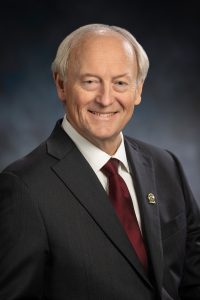Governance & Membership
President's Message - September
'I Came Into This Room for a Reason ...'
By D. Kenyon Williams Jr.

2025 OBA President D. Kenyon "Ken" Williams Jr.
“I came into this room for a reason” is a comment we have all made to ourselves from time to time (go ahead, admit it; you know you have!). You leave one room on a mission and find yourself in another room with no clue about the original mission – until you go back to your starting point and the memory of the mission is triggered, or you still cannot remember why. And no, this is not a sign that your faculties are failing. According to a 2011 University of Notre Dame study, “Walking Through Doorways Causes Forgetting,” it is the act of walking through the doorway into a different venue that "purges" our memory, as if our brain interprets the change of venue as completion of an event, rendering the old memory irrelevant. At least that is the conclusion of that study.
But just imagine if this happened to you constantly and randomly throughout your day, which is just one of the many signs of dementia or other neurocognitive impairment. And no, I am not suggesting that you are suffering from either just because you forgot why you came into the room!
What I am referring to is the challenging task of distinguishing between signs of normal aging and signs of more serious cognitive decline. The following are just a few examples.
Normal Aging
- Accurate but slower than typical;
- Memory lapses the individual notices;
- Difficulty remembering names and familiar words;
- Forgetting what you are looking for in the other room;
- Awareness of changing capacity and ability to use adaptive strategies to compensate; or
- A tendency to become less flexible
More Serious Decline
- Decreasing accuracy, often along with slowing;
- Memory decline that is noticeable by others;
- Difficulty with learning new things in general;
- Forgetting how to do familiar activities, use appliances or electronics, etc.;
- Lack of insight into changes and the impact they are having on yourself and others; or
- Changes in personality
Why is all this significant? For several years, OBA leaders have been concerned that Oklahoma attorneys have been headed for a severe drop in population (the cliff) as a result of the baby boomer generation aging out. The number of older attorneys still practicing has also been a topic of discussion. By my rough analysis, the mean age of active members in good standing is 55.
At the 2025 Judicial Conference, recently held contemporaneously with the very successful OBA Solo & Small Firm Conference, I was honored to report to Oklahoma’s judges on the “State of the OBA.” One of the observations I provided was that, according to OBA records as of Jan. 1, 2025, more of our active members in good standing are over the age of 80 than under the age of 30. Let that sink in for a moment, and it becomes obvious that Oklahoma is not replacing our aging active members with new members.
This is not a new topic. In 2014, then-OBA President Renee DeMoss initiated the OBA Attorney Contingency Plans and Transitions Working Group Project. The project was intended to address the need for all OBA members to have a transition plan in place to protect their clients in the event of incapacity, death or disappearance.[1] However, there is no similar project to address the need for replacing our aging member population.
As Executive Director Janet Johnson mentioned in “My Midyear Reflection,” her message in the August 2025 issue of the bar journal, one of my primary concerns this year has been access to justice. If you have not done so, please review “Bridging the Justice Gap” by Oklahoma Bar Foundation Executive Director Renee DeMoss, also in the August 2025 issue. The shrinking number of members can only exacerbate the current “justice gap.” I have focused particularly on the “legal deserts” that exist in many of Oklahoma’s lower-population counties. Fourteen of Oklahoma’s counties have six or fewer attorneys. My initial efforts have been to reach out to local leaders in those 14 county seats to open discussions about how we can encourage new attorneys to consider locating their practices in these more rural areas. I sincerely solicit your suggestions regarding solutions for Oklahoma’s legal deserts.
Please spread the word that these discussions are in no way intended to attack or disparage older lawyers. To the contrary, but for the continuing practice of our older members, Oklahoma would already be experiencing an even greater deficiency in access to justice. You may, confidentially if you so desire, provide any comments or thoughts you may have on these topics to me, Vice President Richard White, Executive Director Johnson or any of the members of the Board of Governors. These discussions are more necessary than at any time in our history and seek only the best for all concerned.
As always, thank you for your service to the public and our honorable profession!
D. Kenyon “Ken” Williams Jr. is a shareholder and director at Hall Estill in Tulsa.
ENDNOTE
[1] The project's resulting work, Planning Ahead Guide: Attorney Transition Planning in the Event of Death or Incapacity, is available for download on the OBA website at https://bit.ly/4oOk3kO
Originally published in the Oklahoma Bar Journal – OBJ 96 Vol 7 (September 2025).
Statements or opinions expressed in the Oklahoma Bar Journal are those of the authors and do not necessarily reflect those of the Oklahoma Bar Association, its officers, Board of Governors, Board of Editors or staff.
